Introduction
Beginning in 1989, the Prince of Persia series enjoyed consistent attention, with its longest break between releases being six years between Prince of Persia 2: The Shadow and the Flame and the better-left forgotten Prince of Persia 3D. 2003’s Sands of Time and its two sequels marked a new era for Prince and, in many ways, laid the foundation for Ubisoft’s most successful franchise, Assassin’s Creed. The 2008 Prince of Persia reboot didn’t reignite the series as Ubisoft had hoped, and 2010’s Forgotten Sands felt closer to a movie tie-in than a new, proper entry.
That game’s subtitle would end up being a portend of the future as the series seemed inexplicably lost to time. Though not completely ignored, thanks to the occasional cameo in other Ubisoft games and underplayed mobile releases, we will have gone 13 years without a new Prince of Persia game by the time The Lost Crown is released early next year. We’re well overdue for another chance to explore a Persian location with our impressive parkour skills. We may not have expected the series to go back to its 2D roots for its triumphant return, but based on our discussions with developer Ubisoft Montpellier and playing the game’s first three and a half hours, it may be precisely what we need.
The Sands of Time
The Sands of Time
“I think you should ask [Ubisoft CEO] Yves Guillemot,” says game director Mounir Radi with a laugh when I ask why we’ve had to wait so long for a new Prince of Persia. He genuinely doesn’t have an answer to the question, but his excitement at finally being able to bring the series back is evident.
The Lost Crown wasnʼt an assignment that came down on high from Ubisoft but was instead directed by the team Radi helped put together for the game.
“It’s fully us. It’s not a command,” Radi says.
The moment just happened to be right. The people Radi wanted on the team with applicable skills like expertise in platforming and world-building were finally available within Ubisoft.
“I didn’t want to do any Prince of Persia that I wouldn’t be proud of,” senior producer Abdelhak Elguess says, also citing having the right people be available at the right time be a major factor.
Once the team was assembled it took some time to decide in what direction the team wanted to go. Development began in 2019, which means pending any unforeseen delays, the game has been in development for almost five years.
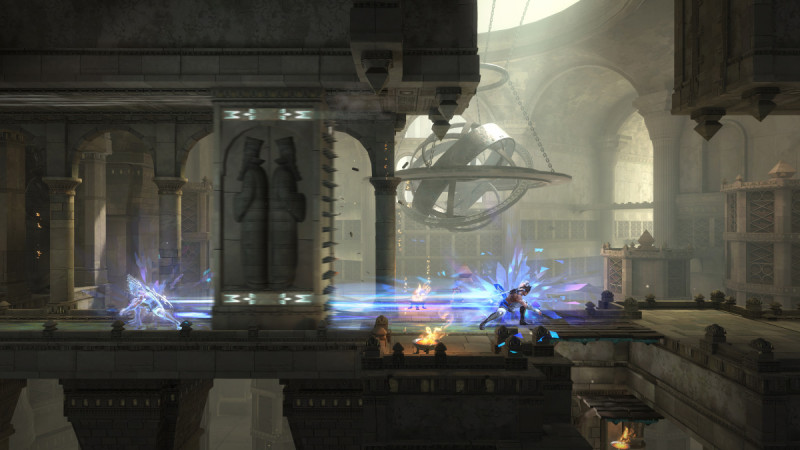
“It was not 2D from the start,” Radi says. “I had the chance to work on some prototypes in 2D, but before going into it, we studied the Prince of Persia series, just to be sure we understand all the legacy.”
That effort meant researching what fans liked about Prince of Persia in all its forms. The team tried to emotionally detach itself from the franchise and focus analytically on what players might want from a new entry. Radi himself is a longtime fan of the series, predating its move to 3D movement, and hoped, specifically, to recall the tone of the original but with a contemporary lens. “I wanted to have a callback to the fear and isolation that I had when I was playing the 2D games,” he says. “And to also push a lot of experimentation with the aspect of the time powers.” That goal of isolation and fear naturally fit into the “Metroidvania” mold – a term Radi offers to describe the game without hesitation. After playing, I understand why. If you liked the structure of 2021’s Metroid Dread, then you should absolutely be paying attention to The Lost Crown.
That isnʼt to say that Prince of Persia’s excellent 3D iterations won’t have representation. Radi is quick to compliment Sands of Time, and the team is doing everything within its abilities to ensure that moving back to 2D does not feel like a regression.
Warrior Within
Warrior Within
Previous Prince of Persia games being an influence on The Lost Crown admittedly goes without saying. To make a new Prince of Persia game without reverence to what came before would be a disservice to the longtime fans. But plenty of other games, and even entire genres, are serving as an influence for this new era of Prince of Persia, too. “Maybe you have heard that I am a big fan of fighting games?” Radi asks. “They achieve, I think, in the right way, the spectacular aspects of 2D action. I wanted to bring this to the screen.” Fighting games can scare away some, however, with their complicated inputs and focus on educating players for some time before they feel they have a grasp on the action. “I understand that when talking about certain [fighting] games it can sound like complexity, but this is not that for me,” Radi says. He cites games like Smash Bros. and Street Fighter that have a “super elegant” one attack, one function approach. “I wanted to take some aspect of the fighting games and make them much more straightforward.”
Watch 20 Minutes Of The Lost Crown Gameplay
Only speaking to Radi, I was unclear of exactly what he meant, but getting hands-on with the game, I have a much better feeling for how protagonist Sargon (who notably is not a Prince) attacks a little bit like a fighting game character. You do not perform combos with your swords by memorizing button patterns. You only use one button for sword attacks, but I was much more thoughtful about attacking enemies against walls and dashing into an attack to kick enemies into the air and bring the fight to the sky. It’s also worth noting that the combat is very fast and very fun. Counters play an essential role and Sargon makes big sweeping attacks with his dual swords that feel great. I also like the focus on positioning and sliding under enemy legs or jumping over them to get the best angle of attack instead of unlocking button patterns. It made every encounter feel seamless and thoughtful. You also build up a meter to unleash a devastating special attack that is very important to manage, especially during boss fights.
Alongside Radi’s fighting game interest comes expertise from some of the best platform designers in the industry. Much of The Lost Crown’s team worked on Rayman Origins and Legends, and the main lesson from those games the team is applying here is a sense of musicality and rhythm in platforming – though you shouldn’t expect any rhythm levels like the ones seen in Rayman Legends. “For me, and for a lot of people on the team, the action on-screen is music,” Radi says. “When you work on a game such as Rayman, you learn how to convey this aspect into gameplay.” Radi adds that when the team talks about how it wants the player to make Sargon bounce between walls or sprint through an area, it find itself gesticulating as if conducting in rhythm. Prince of Persia: The Lost Crown is quite different from Rayman, but in my time playing, I can feel the lessons learned from those games applied here.
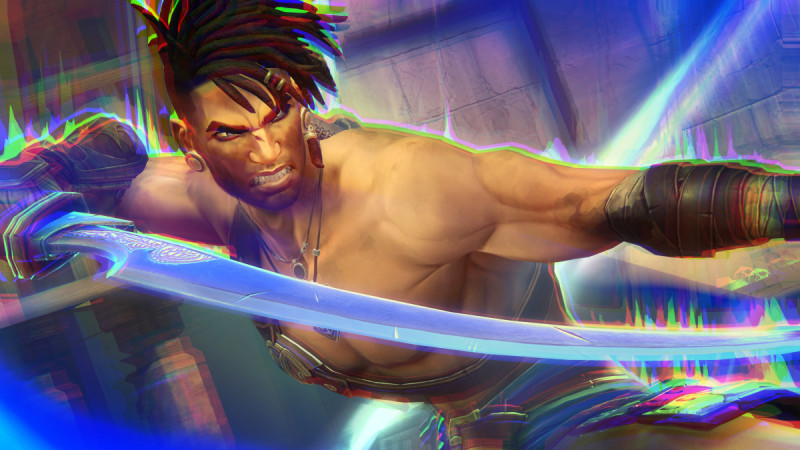
Most Think Time Is Like A River
Most Think Time Is Like A River
Typically, in preview opportunities where we get to play a game ahead of release, we’re dropped into the middle. This way, we avoid spoilers and early lengthy tutorials to, ideally, get a sense of a game when a player has already spent some time understanding how it plays. Perhaps as a show of confidence, Ubisoft let me play from the very beginning and then what felt like a significant way into the story. I won’t spoil its biggest narrative surprises, but it did not take long for its hooks to be fully planted to the point I was disappointed I had to stop. Iʼll be more than happy to replay the game’s opening hours again in January.
Before even starting, I changed the spoken language to Farsi (Persian in the game’s settings), which will be an option at the game’s launch. There are also difficulty options and Guided and Exploration modes. The former offers more map guidance for those who don’t like getting lost, while the latter gives fewer player hints. The game begins on a battlefield with Persia defending itself from the Kushans, warriors from the east. Hope seems lost until The Immortals appear – seven ultra-powerful warriors with magical abilities who quickly turn the tide of battle.
The player controls Sargon, the youngest of The Immortals. The team drops into battle like a bomb, taking out swaths of the competing army at once. The game’s opening teaches you how to play as Sargon while the six other Immortals fight beside you. They are all unique, with specific designs, silhouettes, abilities, and personalities. This first area also introduces you to Sargon’s teacher, Anahita, who is not a member of The Immortals but also appears to be a skilled warrior.
Making my way through the battlefield is straightforward. I won’t have a Metroid-style map until later. I learn how to jump on walls, use basic attacks, and when to counter. This tutorial area ends with a fight against General Uvishka, the leader of the Kushans, who is twice as big as Sargon and mounted on a horse. The battle is difficult, and it takes me multiple attempts. Appropriate counters are critical, as is making sure I use my health potion at the right time, which I later learn refills at every checkpoint, like Dark Souls. Defeating General Uvishka strikes the right balance of challenge and satisfaction. He kills me a handful of times, but I never felt like I couldn’t beat him in my encounters.
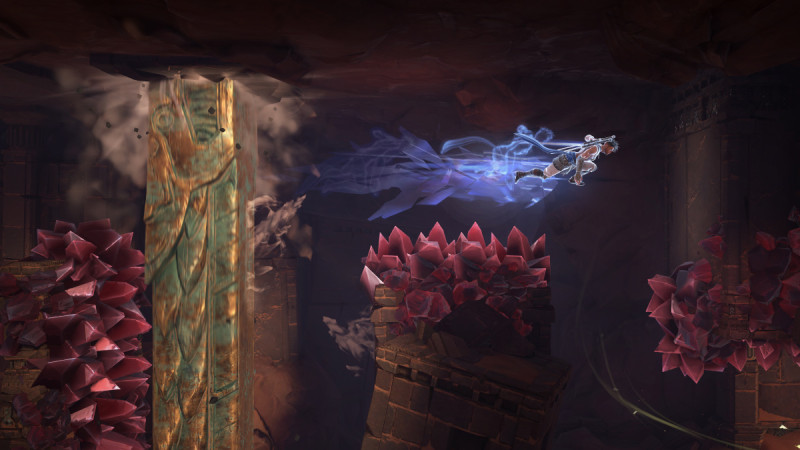
With the bombastic opening out of the way, itʼs time to better understand who Sargon is and what is happening in this world. Sargon’s Immortals peers are impressed by his skill. Their relationship with him is one of proud teachers. They let him take on General Uvishka so he could finally get some recognition after all their teachings. The Persian Queen Thomyris awards Sargon a blue sash for his substantial efforts, which makes him look a little like the Prince from Sands of Time.
However, the most important character we meet is Prince Ghassan, the reluctant royal who is technically the titular Prince of Persia. He suggests meeting Sargon under more casual circumstances in the future. Sargon meets with the other Immortals to share in their victory, but the moment of respite is short. The kingdom is attacked, seemingly from the inside, and Prince Ghassan is kidnapped. Sargon rushes after him to discover that Anahita, Sargon’s teacher, is taking Prince Ghassan, and she seems to be more powerful than she let on. This leads Sargon and The Immortals to chase and follow Anahita and Ghassan to the mystical Mount Qaf, former home of the god of time, where The Lost Crown takes place.
The Fallen King
The Fallen King
Mount Qaf is a dangerous, magical place that people explore at their own risk. Those who go there do not seem to return, but The Immortals are loyal and enter without question to save their prince. It does not take long for things to go wrong. The Immortals break into groups and begin looking for Ghassan, but Sargon is on his own. The Lost Crown begins to take on a familiar, Metroid-inspired structure. Multiple paths make themselves apparent, but most require a new ability. The Immortals also come across a recognizable decomposing soldier who looks like they have been dead for years, even though they are confident they would have only arrived a few hours ago.
A path of floating leaves directs me to a Wak-Wak tree, which I learn is the recurring save spot that appears throughout the game. A young girl named Fariba appears from the corner, claiming she has been here for years and knows everything about Mount Qaf. She is surprisingly cavalier about the whole situation and is entirely unimpressed by Sargon being a member of The Immortals. She gives Sargon the Eye of the Wanderer and a map that is more than it first appears.
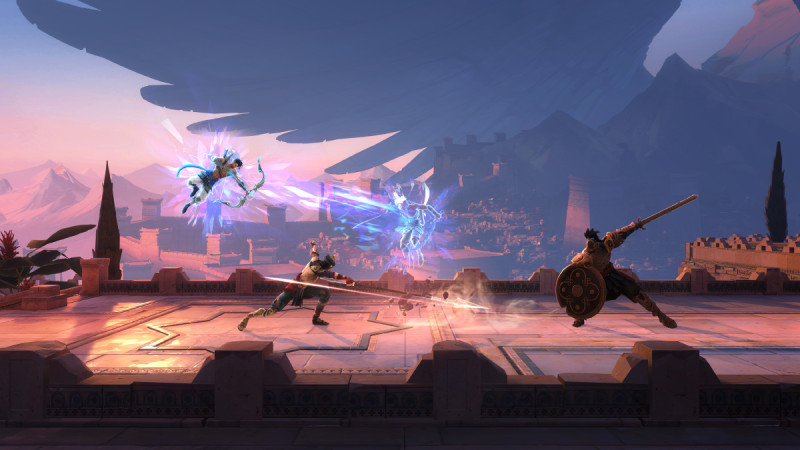
Using the map, players can leverage a mechanic called Memory Shards. At any moment, you can press down on the d-pad to take a picture of your surroundings, automatically marking the map with a photo. I love this feature and frequently take advantage. It’s the equivalent of making notes on your map. If a ledge was too high, I took a picture of it to note that I probably needed some kind of double jump before I could progress there. I did the same for odd-colored doors or other comparable hurdles I knew I was not yet ready to overcome.
As I continue exploring, I run into members of The Immortals, but everyone has strange stories. I have only been playing for about 30 minutes, which Sargon seems to be experiencing in real-time, but some members say they have been exploring for days. I find one exhausted soldier who isn’t a member of The Immortals who claims they have been there for years. The strangest moment is when I find a dead body resembling Sargon with one of The Immortals’ unique weapons, Monolias’ bow. I take the bow from the body, grateful for the new weapon, but then run into Monolias later in the game. He still has his bow, meaning a different version of him and his bow must have existed. Time moves strangely on Mount Qaf, which is thematically consistent for Prince of Persia. The games have always had an element of time, whether it was the hour-long timer of the first game or the ability to rewind time in Sands of Time.
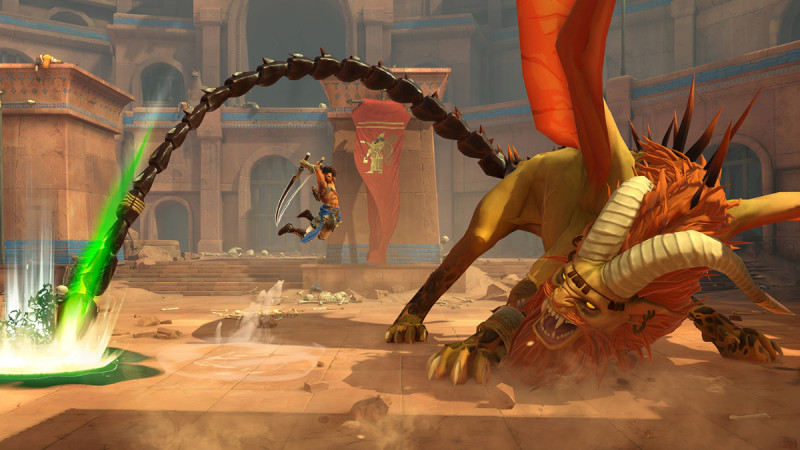
I eventually find Anahita and Prince Ghassan and manage to follow them, but not before encountering Kaheva, a true immortal, surviving god, who offers to upgrade my equipment. I also fight Jahandar, a winged lion with a scorpion tale. Like General Uvishka, Jahandar makes for a challenging but rewarding boss fight.
To delve more into the story would enter the world of spoilers, but I will tease that I was very surprised at some of the revelations I encountered about Sargon, Prince Ghassan, Anahita, and members of The Immortals – and that was only in the first three hours of what Ubisoft is estimating to be a 25-hour game. I explored a library filled with alchemists who seemed to be different versions of the same person and only some of them attacked. I discovered a forest filled with mushroom platforms, and even ended up in the sewage-soaked depths where an old man stole my map and demanded I chase him. I also got an exclusive early look at an area called The Pit of Eternal Sands.
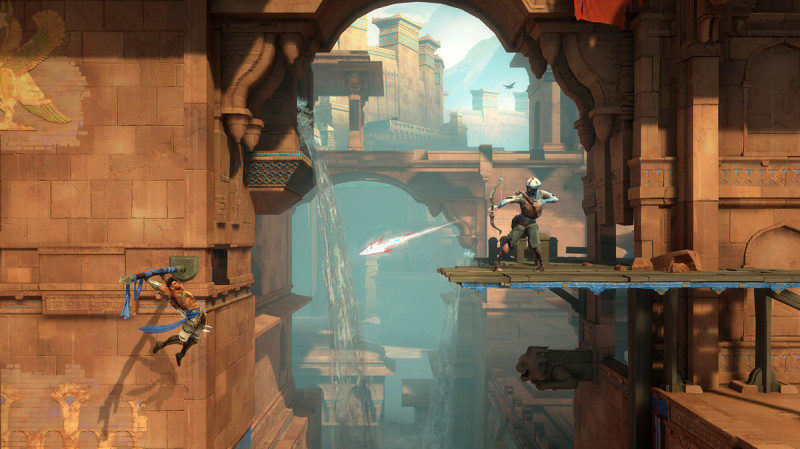
The Pit Of Eternal Sands
The Pit of Eternal Sands
I was not able to play in the Pit of Eternal Sands, but I did get to see some hands-off gameplay of the location, which revealed new time-bending mechanics. This area is arguably the one most inspired by Sands of Time. Along with the pit being full of sand, everything in this area of Mount Qaf is in reverse. Sargon rides giant waterfalls of sand that are climbing upward, and even enemies move in reverse. When you kill them, you see their spawn animations, and when they come to life to attack, you actually see their death animations. “These are the kinds of things we wanted to do to toy with and surprise our player,” Radi says. “Sometimes, these time anomalies are depicted thematically. Sometimes they have a real impact on gameplay.”
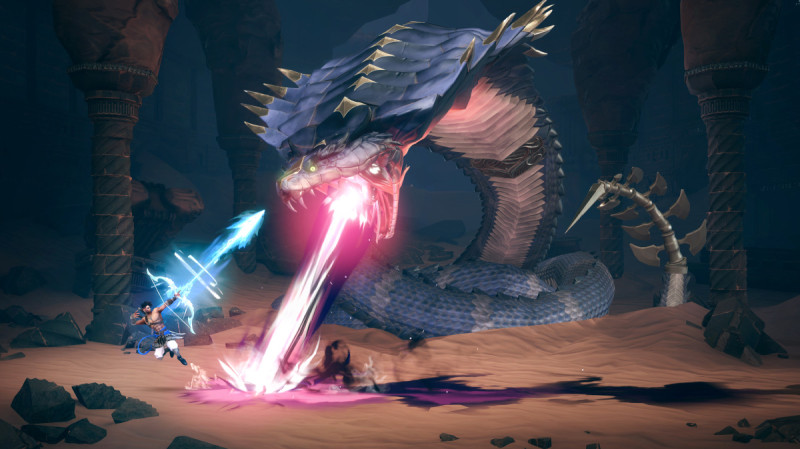
Footage from The Pit of Eternal Sands also showcased Azdaha, an imposing gigantic cobra boss fight. Like the boss battles I played myself, Azdaha looks challenging, but also the kind of boss that clearly communicates its intentions, which makes it easy to blame yourself for failure rather than the game. In the boss fight, Sargon used a time manipulation ability I was not able to use myself, where he would execute a jump and a mid-air dash but then rewind time to give himself another opportunity to jump in mid-air. Sargon used the ability to get himself out of Azdaha’s way, but I also saw him use it while exploring to make disappeared platforms reappear and give himself more time in the air. The mid-air dash Sargon used extensively here also directly references Sands of Time’s wall running ability. Sargon can use it without the aid of a wall, but the animation looks almost identical to the 2003 game’s animation in a fun, referential way.
Time Is An Ocean In A Storm
Time Is An Ocean In A Storm
I have a lot of affection for Sands of Time. It was the kind of game I fell in love with so thoroughly that I was disappointed I couldn’t run along walls or rewind time when I played subsequent games. The story also felt unique in ways that have become standard. Allowing characters to develop by having personal conversations not necessarily related to the task at hand was uncommon, but the Prince and Farah would do things like discuss their favorite fruit, and the romance that developed over the course of the game felt earned. I played every follow-up sequel and am so grateful the series is finally making a return.
Metroid was not the inspiration I expected to influence the next Prince of Persia, but spending hours with the game has convinced me it is an excellent fit. I am already invested in Sargon and The Immortals, eager to see what happens next in the story, and equally excited to see what abilities will develop over the rest of the game. We are well overdue for Prince of Persia’s return, and while I was always hopeful a new entry would be worth the wait, after playing the game, I have confidence it will be.
This article originally appeared in Issue 362 of Game Informer
Source link
